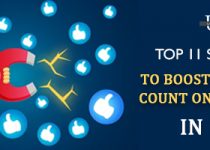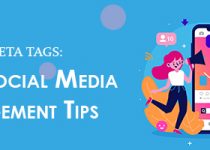20Nov 23 Critical Social Media Management KPIs in 2023

Social media key performance indicators are especially important if you want to create a wonderful social media strategy. Keeping a tab on each metric while you are creating a social media post can be stressful. However, if you can utilize all the information in the right way, you can get a massive performance boost.
In this article, we will discuss the top 17 KPIs that will help you track the success of your social apps. You can create a roadmap to ensure you achieve a winning social status.
Significance of Social Media Metrics or KPIs
Social media KPIs indicate how your social media is performing. It assigns data points to analyze the performance and also gives you an insight into how you can improve. The scorecard you see is based on the number of people who saw your post, liked, commented, or shared them. The KPIs can also keep you informed on the amount you are spending and the ROI you generate.
Tracking is a significant aspect of driving your numbers higher. You can get a global picture of what’s your standing in the market.
Paying attention to key performance indicators can help you build an informed social media marketing strategy. Align your social media efforts to match your business goals for optimal results. Also, it becomes difficult for you to identify downward trends that require a strategy change.
Let us go through wonderful social media KPIs that you must track in 2023.
Social Media Engagement KPIs
Social media engagement metrics reflect how users interact with your content. It is important to track these KPIs for the following reasons. For instance, engagement shows how many audience members are actually interested in your content and willing to take some social action
Engagement also sends powerful signals to social media algorithms to help you gain greater reach.
Engagement rate refers to a pointer that indicates the number of engagements (likes, comments, shares) your posts receive from a certain percentage of your audience.
The number of audience can be relative to you. For example, you can consider the number of visitors your website gets or you can count the number of followers. It is important to note that all the followers will not come across your post.
Engagement Rate Calculation Technique
There are multiple techniques to calculate the engagement rate. You can collectively add the number of shares, likes, saves, and comments. Divide the engagement numbers by the total number of followers and multiply the result by 100 to get your accurate percentage.
Amplification rate
Amplification Rate refers to the ratio between shares per post and the total number of followers. It is basically the rate at which your followers consume and share your social media posts using their channel. The greater the amplification rate, the higher the chance for your followers to promote your products to the new range of audience.
Dividing the total number of shares by the total number of followers gives you the amplification rate when you multiply the division result by 100.
Virality Rate
The virality rate is the same as the amplification rate. And it calculates the extent of the shared content. In addition to this, the virality rate also measures the impression percentage instead of the follower percentage.
It is worth noting that every share your content receives invites a fresh set of impressions from the people who follow them. Therefore, the virality rate also calculates the way your content can potentially spread exponentially.
You can easily calculate the virality rate by dividing the number of shares received on a particular post by the number of impressions and then multiplying by 100 to gain the virality rate percentage.
Brand awareness metrics for social media show you a complete picture of the people who are actively engaged with your brand.
Reach
Reach is a vital metric to determine viewer count for your online content. Monitoring your average reach can help you understand what is working and what is not. It is crucial to keep a note of each post, video, or story to build a successful social media strategy as well as your entire profile or page.
It gives you an outline of the percentage share between who are active followers and who are lost to your competitors. Your reach percentage is reflected high from the non-followers end if it is shared externally and extensively.
Impressions
Impressions indicate the number of views you get on each post from a single user. Now, you may find that there are several impressions on your posts but the reach rate is comparatively lower. The reason behind it is that one user may watch the same video many times. It is important to understand what aspects of your post drive people to interact with it longer.
Video Views
Video Views is a metric that measures how many people have attempted to watch your video. There are ample social media platforms today, and what constitutes a “view” varies across all these platforms
Very little difference in a watch time even by seconds can make you miss out on views.
Rate of Video Completion
Using video views you get the data and calculate how many people started watching your video content. But how do you really analyze how many people have gone through the entirety of the video? The video completion rate is an indication of how many people are choosing to stick with your video until the very end. It is a wonderful metric that showcases if your content is high-quality and has the potential to connect with the target audience.
Growth Rate for the Audience
Audience growth rate is a measure of the rise in follower count within a dedicated duration of time.
Calculating audience growth rates can be tricky. When you are just starting with your content creation, your total number of followers may be less. Therefore, even when 5 new followers follow you in a month, the rate stays higher. When, your follower count is in the millions, even a 10-follower addition within a dedicated time can lower the audience growth rate.
You can easily calculate your audience growth rate by consolidating all new followers in one list calculated over a specific duration. This entire sum can be divided by the audience (all views and shares you receive) and multiplied by 100.
Click-Through Rate (CTR)
CTR is a measure of how many times users click on a link present on your social media platforms to access more in-depth information. They may access your website, YouTube video, or online e-commerce store.
Looking into the click-through rate, you can understand how many people were influenced by your post and what type of language attracts people to your main content.
Total number of clicks on a single post
CTR = ___________________________________ *100
Number of impressions
You can use the shared formula to easily calculate your click-through rate.
Rate of Conversion
Conversion rate is the rate at which your visitors or viewers are converted into customers. Conversion could be of several kinds. It can be a download, a subscription, or a sale. Calculating the conversion rate will show you how fruitful your social media campaigns are whether they are organic or paid.
Cost-Per-Click (CPC)
Cost-per-click is a company investment to pay for any ad they want to promote and which is clicked by the user. When you have proper data on the lifetime value of your customer or you can determine the average order value, you will know how much budget allocation is safe.
Manual CPC calculation is not required as you can find the data in the social media analytics dashboard of your social network platform.
Cost Per Thousand Impressions (CPM)
The cost for a thousand impressions determines the amount you need to invest in your social media advertisement campaigns to get 1000 impressions.
The CPM data is also visible on social media analytics and can be imported easily to ready reference.
Time for Average Response
Average response time is the measure of the average time it takes for the company to give the first response to an individual query. It clearly expresses how good your customer support service is. Social media management tools can help you be on top of things and ensure your reply reaches your customers in time.
Leveraging AI bots is an excellent social media marketing strategy because it will deal with minor issues without requiring your attention. It will help you save time and streamline the transfer process effectively.
Using analytical tools you can easily calculate the percentage. To find the data manually, all you have to do is add the total time taken to give the first response and divide it by the number of queries received.
Customer Satisfaction Score
CSAT scores are based on one simple principle- Overall consumer satisfaction. CSAT analyzes how satisfied your customers are with your customer support strategy via social media platforms. It also helps you analyze the social media performance.
Brands always try to monitor the customer support experience with customers. This is why you always get a survey link to share your experience. You can adopt the same technique for your brand and create a questionnaire to request feedback on the agent who addressed the issue. You can send the question via email, select social platforms, SMS, phone calls, etc. You can gather all the responses and tally the number by dividing it by the number of responses and further multiplying it by 100 to get the percentage.
Net Promoter Score
Net promoter score measures the level of loyalty in your customers. NPS is an excellent metric that determines what your future relationship with customers will look like. Customer loyalty depends on the recommendation factor. Whether a customer wants to purchase from you again or how likely they are to promote your products among their peers translates to customer loyalty.
In a survey, customers are often asked how likely they are to recommend specific products or services to their friends and family on a scale representing low to high. For example, the scale
- 0-10 groups customers into 3 broad categories based on their responses.
- The Customers who fall under the 0-6 score range are known as Detractors.
- Customers who fall within the score range of 7-8 are called Passives.
NPS is excellent at measuring two parameters – customer satisfaction and future sales prospects. Therefore, it is an extremely valuable metric to keep a tab on whether you are a large-scale business or a small enterprise.
Calculating the NPS is easy. You can calculate the difference between the detractors and the promoters. Divide the number by the total number of responses received and multiply the solution by 100.
Social Voice Share Count
This metric depicts the buzz created around your brand which directly or indirectly helps you reach social goals. It measures how many people are talking about our brand and draws a comparison between you and your competitors. You can keep a tab on tags and mentions using different platforms.
You can measure this metric by adding up all the mentions and tags your brand receives and you can divide the number by entire mentions from the industry and multiply the solution by 100.
SSoV is a competitive analysis to identify the brand’s online visibility and relevancy in the marketplace.
Social Sentiment
SSoV analyzes how many people are talking about you. Social sentiment measures the sentiment behind the conversations. It can calculate if people are happy and satisfied with your brand or if your products and services are not pleasing your buyers. Certain tools are specially designed to interpret human sensibilities and language complexities to understand whether your audience is talking negatively or positively about your brand.
Social Media Metrics Dashboard
All the social media platforms are equipped with a social media metrics tracker. These trackers are adept at monitoring and analyzing the collected data and help you build an effective social media marketing strategy.
It may be overwhelming to jump to different social media platforms to check the individual platform analytical sections and sum it up. You can use free tools such as Hootsuite that can help you collate data from different platforms and generate a consolidated report. You must make sure that you are thorough with the following analytical tools:
- Twitter Analytics
- LinkedIn Analytics
- Meta Business Suite
- TikTok Analytics
- Pinterest Analytics
It is best to keep a consolidated report so you can understand where you need to put in more effort. These custom reports will also help your team understand which of your strategies are performing well and which ones need to be eliminated. Thereby, promoting transparency within the team.
Wrapping Up
The purpose of using social media platforms is to promote your products and services to your target audience. Monitoring the performance is the only way to ensure that you are headed on the right track. Building your social media marketing strategy based on the above-mentioned parameters will help you to grow a loyal follower and customer base. The CTR, CPC, AER, etc will support your tracking goals and help you achieve your social media goals.
It also helps you understand where you stand for your audience. Also, it helps you predict the futuristic trends that will strengthen your social media strategy to a great extent. Adopt these metrics in your monitoring idea and set yourself up for success.
Are you wondering, how you can adopt these and what tools to use? UsePerWish will help you through all the complexities of social media management and handle your tasks with care and precision. Trust your experienced virtual assistants to deliver results that surpass your imagination.


